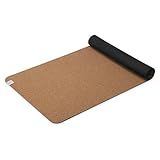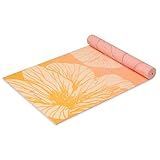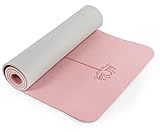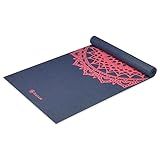Best Eco-Friendly Yoga Mats to Buy in November 2025

Yoga Mat Non Slip, Eco Friendly Fitness Exercise Mat with Carrying Strap,Pro Yoga Mats for Women,Workout Mats for Home, Pilates and Floor Exercises (Matcha Green/Black, Thickness-6mm)
- ECO-FRIENDLY MATERIAL OFFERS SAFETY AND COMFORT FOR WORKOUTS.
- DUAL-LAYER ANTI-TEAR DESIGN ENSURES OPTIMAL GRIP AND DURABILITY.
- INCLUDES FREE CARRY STRAP AND STORAGE BAG FOR EASY TRANSPORT.



Gaiam Cork Yoga Exercise Mat | Natural Sustainable Cork Resists Sweat and Odors | Non-Slip TPE Backing Prevents Slipping| Great for Hot Yoga, Pilates, Fitness Working Out (68" x 24"x 5mm Thick)
-
ECO-FRIENDLY CORK & TPE: ENJOY SUSTAINABILITY WITH EVERY WORKOUT.
-
MOISTURE-PROOF & ODOR-FREE: KEEP YOUR YOGA ROUTINE FRESH AND HYGIENIC.
-
SUPERIOR GRIP IN HEAT: PERFECT FOR HOT YOGA-ENHANCED SOFTNESS WHEN DAMP.



Gaiam Yoga Mat - Premium 6mm Print Reversible Extra Thick Non Slip Exercise & Fitness Mat for All Types of Yoga, Pilates & Floor Workouts (68" x 24" x 6mm Thick)
- EXTRA-THICK CUSHIONING FOR JOINT SUPPORT DURING WORKOUTS.
- REVERSIBLE DESIGN FOR STYLE AND SUPERIOR GRIP ON ANY SURFACE.
- ECO-FRIENDLY AND NON-TOXIC MATERIALS FOR A HEALTHIER CHOICE.



Non Slip, Pilates Fitness Mats, Eco Friendly, Anti-Tear 1/4" Thick Yoga Mats for Women, Exercise Mats for Home Workout with Carrying Sling (72"x24", Parfait Pink & Gray)
- ECO-FRIENDLY TPE MATERIAL: SOFT, LIGHTWEIGHT, AND RECYCLABLE.
- DOUBLE NON-SLIP DESIGN: SUPERIOR TRACTION FOR ALL WORKOUT TYPES.
- INCLUDES FREE CARRY STRAP: CONVENIENT STORAGE FOR ON-THE-GO.



Gaiam, Yoga Mat 4 Mm Pink Marrakesh
- LIGHTWEIGHT DESIGN FOR EASY TRANSPORT AND JOINT CUSHIONING.
- STICKY NON-SLIP TEXTURE ENSURES SUPERIOR GRIP AND STABILITY.
- NON-TOXIC, 6P-FREE MATERIAL: SAFE FOR YOU AND THE PLANET.



Yoga Mat Non Slip, Eco Friendly Fitness Exercise Mat with Carrying Strap,Pro Yoga Mats for Women,Workout Mats for Home, Pilates and Floor Exercises (Grey Blue/Black, Thickness-6mm)
- ECO-FRIENDLY MATERIAL ENSURES SAFETY & SOFTNESS FOR EVERY WORKOUT.
- ANTI-SKID, DURABLE DESIGN ENHANCES GRIP WITHOUT SACRIFICING COMFORT.
- COMES WITH FREE CARRY STRAP & STORAGE BAG FOR ULTIMATE CONVENIENCE.



StrongTek Eco-Friendly Cork Yoga Mat, 7mm Thick, 72"x24", Cork+TPE, 2 lbs, Non-Slip, Lightweight & Cushioned Mat for Hot Yoga, Pilates & Home Fitness, Durable Surface with Natural Grip and Carry Strap
-
SUPERIOR TRACTION WITH SWEATY SESSIONS: NON-SLIP CORK SURFACE!
-
LIGHTWEIGHT & TRAVEL-FRIENDLY: EASY TO ROLL, CARRY, AND USE.
-
CUSHIONED SUPPORT: 7MM THICK FOR COMFORT & JOINT PROTECTION!



Yoga Mat Non Slip, Eco Friendly Fitness Exercise Mat with Carrying Strap,Pro Yoga Mats for Women,Workout Mats for Home, Pilates and Floor Exercises (Purple/Teal, Thickness-6mm)
-
ECO-FRIENDLY MAT: SAFER, SOFTER THAN TRADITIONAL PVC & EVA.
-
SUPERIOR GRIP: DOUBLE-LAYER, ANTI-SKID DESIGN ENSURES STABILITY.
-
CONVENIENT CARRY: COMES WITH FREE STRAP & STORAGE BAG INCLUDED!


In recent years, eco-conscious living has become more than just a trend; it's a lifestyle choice for many. Yoga enthusiasts, in particular, are leading the charge towards sustainability, choosing eco-friendly yoga mats that align with their values. In this article, we explore the essentials of eco-friendly yoga mats and help you choose one that’s perfect for your practice.
What Makes a Yoga Mat Eco-Friendly?
Eco-friendly yoga mats are designed with sustainability in mind at every stage of their lifecycle. They are typically made from natural, biodegradable materials like natural rubber, organic cotton, jute, or cork. These materials not only reduce environmental impact but also offer excellent grip and cushioning.
Key Features of Eco-Friendly Yoga Mats
- Natural Materials: Eco-friendly mats steer clear of PVC and other synthetic materials, opting instead for plant-based materials.
- Biodegradability: Once they reach the end of their usable life, these mats decompose naturally, reducing waste.
- Non-Toxic: They are free from harmful chemicals and dyes, making them safer for both users and the planet.
- Durability: Contrary to common misconceptions, eco-friendly mats can be just as durable as regular mats, thanks to innovation in material processing.
Benefits of Using Eco-Friendly Yoga Mats
Choosing an eco-friendly yoga mat offers numerous advantages beyond sustainability. Here are some key benefits:
Enhanced Grip and Stability
Natural materials often provide a superior grip, helping yoga practitioners maintain stability during poses and transitions. This is particularly beneficial for practices like hot yoga, where sweat can cause slippage on conventional mats.
Gentle on Skin
Eco-friendly mats are free from harsh chemicals, making them a safer choice for people with sensitive skin or allergies.
Mindful Practice
Using an eco-friendly mat can enhance your overall yoga experience by promoting a mindful approach to health and wellness. It’s a subtle reminder of your commitment to a harmonious relationship with the Earth.
How to Choose the Best Eco-Friendly Yoga Mat
When selecting an eco-friendly yoga mat, consider the following factors:
Material Thickness
Material thickness affects the cushioning and support the mat provides. Thicker mats (around 5mm to 6mm) offer more cushioning, which is ideal for those with joint issues or preferences for softer surfaces. Thinner mats provide stability and are easier to transport.
Weight and Portability
If you often take your yoga practice on the road or to a studio, consider the weight of the mat. Lightweight mats are easier to carry, though they may offer less cushioning.
Texture and Grip
Evaluate the mat’s texture to ensure it provides adequate grip and comfort during your practice. This varies among materials; for example, natural rubber offers a sticky feel, while jute provides a firmer, textured surface.
Price Point
Eco-friendly mats come in a range of prices. Determine a budget that fits your financial plan while considering the mat's sustainability, material quality, and durability.
Considerations for Complementary Yoga Accessories
While a mat is essential, integrating complementary yoga accessories can enhance your practice. Consider pairing your eco-friendly yoga mat with tools like best yoga wheels and best yoga blocks for beginners for added support and versatility.
Conclusion
Choosing the best eco-friendly yoga mat is a meaningful step towards a sustainable lifestyle and enriched yoga practice. By selecting a mat made from natural materials, you contribute positively to the environment and enjoy a healthier, more mindful yoga session. Explore your options and invest in a mat that aligns with your values and needs.
